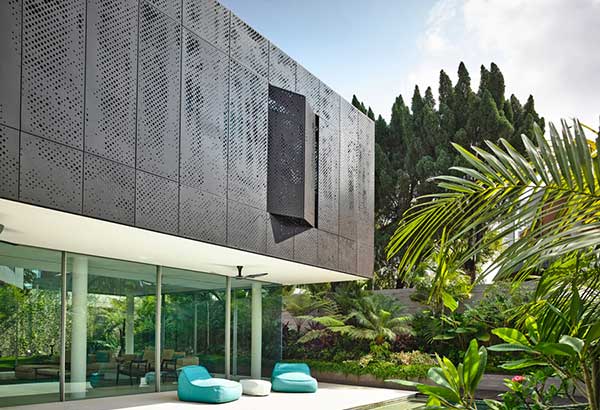Tropical architecture for the 21st Century


This modernist home in Singapore sits on a 740-sqm. slot — big for Singapore standards.
(Part two)
A few weeks ago I introduced a new book, Tropical Architecture for the 21st Century, the second in a series on excellent Asian design by BluPrint magazine of the One Mega Group. The first book, Blueprints for 2050, which came out in 2016, was a top-seller in its category. This book is another winner.
The new publication was launched last Aug. 16 at the Maybank Performing Arts Theater in Bonifacio Global City. The launch was also a celebration of BluPrint magazine’s 18th anniversary. Judith Torres, current editor in chief, hosted a theater full of architects, designers and aficionados of design, at the six-hour launch event that included lectures by key architects featured in the book.
I’ve been out travelling for the last few weeks. This week, I’m catching up with my writing and am featuring part two of my review of the new book. In the first outing we showcased the Filipino tropical homes in the lineup. Today we look at the masterpieces of tropical design located in Singapore and Malaysia, which were chosen for the glossy tome.
The book features 21 homes, 11 from the Philippines, five from Singapore and five from Malaysia. They all share commonalities in climactic adaptation, with the active use of passive interventions like cross-ventilation, wide overhangs, brise soliel, and pierced screens.
I stated in the foreword for the book: “All (the featured homes) transcend the historical transects of the vernacular, colonial, post-colonial, independence, and post ’90s Asian crisis manifestations of material heritage and architecture shared by the three countries. These projects run the typological gamut from urban shop house or terrace house adaptive re-use, to re-appropriated sites in suburban gated-enclaves, to innovative earthquake and typhoon-proof exurban second-home escapes.”
I also pointed out: “…(The) projects in this book are new takes on the modernist approach of turning traditional homes on their head with the gardens on top and the main mass of the structure on a bed of (round metal) columns or piloti. A number of the homes featured throw out the playbook on cultural practices of locating bedrooms on the top and locating more public and social spaces on the lower floors (the Fabian Tan-designed home in Kuala Lumpur).”
The 10 homes by Malaysian and Singaporean designers are distinctive in the nature of their individual sites, with roughly a balance between urban shophouse situations and the other half suburban locations. Densities in Singapore and Malaysian sites here are mitigated by building to property lines and innovative adaptive repurposing of courtyard typologies or vertical stacking of spaces. Larger sites rely on green walls or landscape buffers and almost all blur the lines between the spaces inside and outside transforming most to garden homes or green homes instead of houses and gardens.
The cover of the book is one of the Singaporean homes. Designed by the firm of Ong & Ong (I had worked as a landscape architect on projects with them back in the 1990s). There is something to be said about the stark but pleasing contrast of modernist architecture and its cubist geometries against the soft milieu of the tropics.
The same can be said for the Malaysian homes featured in the book. Malaysian architects are brass designers, un-fearing when it comes to bringing out the rough textures of concrete and using this play of textures and surfaces in compositions that make a clear statement of tropicality.
The book is a must for young Filipino architects wishing to gauge themselves against the high standards of regional practices and individual creative geniuses. The book also proves that the necessity of documenting architecture has not changed.
I end my foreword to the publication: “This book and its future editions render a necessary service, that of providing discourse and agency. To paraphrase an old politician: We shape our lives and our lives shape our architecture. As importantly, how we document our architecture, also shapes it and our lives in return.”
* * *
Feedback is welcome. Please email the writer at paulo.alcazaren@gmail.com. Tropical Architecture for the 21st Century is available at all major bookstores.



















